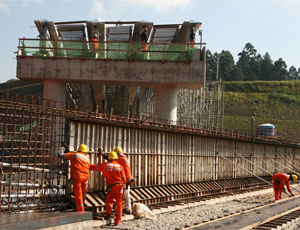When the financial crisis originally struck in the United States in 2007, the initial effect in Latin America was muted. That changed last year as the dramatic drop in purchases pounded commodity prices — the backbone of most Latin economies. Moreover, as investors began seeking safe havens the availability of funding shrank as well.

As a result, since late last year, countries across South America have launched a variety of stimulus measures. Most are multi-billion-dollar initiatives that include a public-works program to increase employment and subsidized loans for consumers to increase spending.
Brazil’s economy is indicative of the situation. Although the U.S. mortgage crisis had little effect, the country’s stock market, the Bovespa, fell a record 41% last year due to the dramatic slump in commodity prices hammered the country’s economy. Credit losses and write downs in the South American nation topped $1 trillion.
Brazil’s monetary authority is now expecting the country’s economy will contract for the first time in 17 years.
Efforts to avert the crisis began in late 2007 when Brazilian President Luiz In�cio Lula da Silva launched a $210-billion investment plan aimed at spurring the economy that has been increased by $59.5 billion. The government also slashed taxes by $3.5-billion hoping to bolster the financial system.
In December Peru’s President Alan Garcia announced valued at $3.3 billion in a move to keep the country’s growth rate at a relatively robust 6.5%. Argentina unveiled a similar $3.8-billion stimulus package that same month but in an effort to bolster financial confidence in the face of $22 billion in debt payments due this year.
Chile has also rolled out a stimulus plan as a means of spurring an economy being dragged down by dwindling commodity exports — particularly copper. The $4-billion effort leans heavily on financial support for ailing sectors but also includes $700 million of that destined for public works projects.
The skyrocketing prices of metals over the past decade provided an opportunity for Peru and Chile to pay off debt obligations, helping shield their economies somewhat now those commodities are languishing.
The situation for Argentina is much more precarious as its ability to obtain debt has been hampered due to the lingering effects of a $95-billion debt default in 2001. Late last year, Argentina’s president Cristina Fernandez Kitchener announced a $21-billion stimulus package of which more than 80 percent would be focused infrastructure projects in hopes of doubling employment in the country’s construction sector.
If fully implemented, package will represent the 5 percent of 2009 economic output — far beyond the 2% being recommended by the International Development Bank for developing economies to stave off the financial crisis.
Kitchener said the effort will be financed by pension fund investments now under the government’s control. Last October, the president nationalized country’s $30-billion private pension fund system in a move that allowed Argentina to pay off its short-term debt obligations but spooked investors.
No one knows yet whether or not the gamble to use the pension system to finance the stimulus effort will pay. Yet the often dramatic infrastructure development needs in many Latin American countries may provide opportunities for spending that many more developed nations simply cannot match.
For example, last month Brazil’s President Lula unveiled an initiative to construct 1 million homes for the poor. That effort is possible due to a dramatic shortfall in low-income housing. According to the Brazilian Construction Chamber, the country needs to build more than 7 million homes in the next 15 years to meet the current demand of families earning less than $900 a month.
It will also help the government counter rising joblessness in Brazil — which reached a seven-year high of 8.2% in January.
The move to bolster Latin American infrastructure investment has been prioritized by international lending organizations — notably the World Bank.
Last year, the World Bank announced it would provide an extra $100 billion in financial support to developing nations over the next three years in a move that could triple the amount of funds available for infrastructure improvement efforts. The International Bank for Reconstruction and Development's (IBRD) is expected to lend more than $35 billion dollars this fiscal year, an almost 160% increase over 2007-2008.
Two notable exceptions to the stimulus movement are Venezuela and Bolivia whose autarkic economies fueled by hydrocarbon profits have already included such measures. Almost half of Venezuela’s estimated $77.9-billion budget this year is earmarked for social spending.
In Ecuador, President Rafael Correa has launched a dangerous strategy of simply refusing to pay foreign loans. In December the leftist leader declared much of the country’s $10 billion in debt “illegitimate” and defaulted on paying a $3.2 billion portion.
Yet, the difficulty for many nations in the southern hemisphere is their inevitable dependence on the success of the Obama package. With economies driven by commodity exports, they have been battered by the plunge in prices since last summer and have little hope for recovery until U.S. demand rebounds.
The scramble to back infrastructure development in hopes of cutting the rate of unemployment and stimulating investment has been repeated across Latin America.

Post a comment to this article
Report Abusive Comment